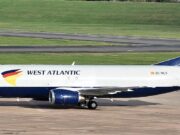
The following information provides an awareness of problems that might be avoided in the future. The information is based on final reports by official investigative authorities on aircraft accidents and incidents.
 Jets
Jets
Fatigue Cited as Factor
Airbus A321-111. Substantial damage. No injuries.
The flight crew had been on duty more than 14 hours when they began the descent to land at Lyon (France) Saint-Exupéry Airport the evening of March 29, 2013. They had flown the chartered Airbus from Lyon to Dakar, Senegal, that morning. The return flight had been delayed about 30 minutes, and a refueling stop in Agadir, Morocco, was required before the crew could continue home to Lyon.
Nearing the destination, the crew learned that the instrument landing system (ILS) approach to Runway 36R was in use and that visibility was 1,100 m (less than 3/4 mi) in mist and light rain, according to the English translation of the accident report released in August 2015 by the Bureau d’Enquêtes et d’Analyses (BEA).
Broken ceilings were reported at 100 ft and 6,600 ft. Surface winds were from 140 degrees at 3 kt, but there were pilot reports of a 15-kt tailwind at 1,500 ft along the approach path. Although both pilots expressed doubts that they could complete the approach, there was no discussion of a missed approach or diversion to an alternate airport, the report said.
The crew had decided to use 141 kt for the approach. However, indicated airspeed was 217 kt and the descent rate was 1,500 fpm when the airplane intercepted the ILS glideslope. Shortly thereafter, the captain reported the approach lights in sight. The airport traffic controller cleared the crew to land on Runway 36R and advised that surface winds were from 130 degrees at 6 kt.
“On passing the stabilisation height at 1,000 ft, the speed of the aeroplane was 57 kt above the approach speed,” the report said. At 500 ft, airspeed was still 38 kt above the target, and descent rate was greater than 1,100 fpm.
The copilot, the pilot flying, disengaged the autopilot at a radio altitude of 200 ft. Shortly thereafter, the autothrottle system inadvertently commanded a thrust increase, and the Airbus crossed the runway threshold at 160 kt. The report explained that the autothrottle anomaly was caused by a fault in the flight management and guidance computer, and was prompted by the airplane’s excessive airspeed as it neared the runway.
There followed opposing inputs on the sidestick controllers, with the copilot holding nose-up pitch and the captain applying nose-down inputs. The opposing sidestick inputs contributed to a prolonged flare, the report said.
The copilot did not retard the throttles, thereby disengaging the autothrottle system, until automatic callouts of “20 feet” and “retard” were generated. Groundspeed was 154 kt when the airplane touched down 1,600 m (5,250 ft) beyond the approach threshold of the 2,670-m (8,760-ft) runway. “The remaining runway distance after the touchdown made it impossible for the aeroplane to stop before the end of the runway,” the report said.
Groundspeed was about 75 kt when the A321 ran off the end of runway. It came to a stop 300 m (984 ft) from the departure threshold on a flat, grassy area and very close to a large and deep ditch. Both engines and the landing gear were damaged during the overrun, but none of the 174 passengers and 7 crewmembers was injured.
The BEA concluded that the accident was caused, in part, by “continuing an approach below the stabilisation height with a speed significantly higher than the approach speed.” Among the factors listed in the report was “a flight duty period of nearly 15 hours which likely led to crew fatigue.”
Descended Below Glideslope
Cessna Citation 500. Destroyed. Two fatalities.
The flight crew had been dispatched to conduct an emergency medical services (EMS) flight at 2240 local time — 20 minutes before the end of their assigned 10-hour on-call period — the night of Aug. 2, 2012. They flew from their base in Santiago, Spain, to Asturias to pick up a cardiac surgeon and nurse, flew the heart-transplant team to Porto, waited for the team to complete its procedure, and then flew them back to Asturias, landing in weather conditions near approach minimums.
According to the report by the Spanish Comisión de Investigación de Accidentes e Incidentes de Aviación Civil, the crew expressed concern about deteriorating weather conditions at the destination and that they did not have enough fuel to divert to their alternate airport. Refueling at Asturias would have involved a delay in departure, because the crew had not made arrangements in advance and personnel would have had to be called to the airport to refuel the Citation.
The airplane departed from Asturias for the 40-minute flight back to Santiago at 0530. Nearing Santiago, the pilots learned that the surface winds were calm, visibility was 4,000 m (2 1/2 mi) in mist and there were few clouds at 600 ft. They were cleared to conduct the ILS approach to Runway 17.
During the initial approach, the copilot had tuned the frequency for the airport’s VOR (VHF omnidirectional radio), which was 1.0 nm (1.9 km) from the runway threshold, to check their distance from the airport. He then inadvertently left the distance measuring equipment (DME) selector on “HOLD,” rather than switching it back to “NAV 1,” the receiver tuned to the ILS frequency.
“The captain would have seen the distance to the runway shortened by one mile on his HSI [horizontal situation indicator], not realizing that the distance was to the VOR [rather than to the ILS DME station],” the report said.
Although the approach was initiated with relatively good visibility, weather conditions deteriorated as the Citation neared the runway. Mist building in the valley where the airport is located periodically reduced runway visual range to 450 m (1,476 ft).
“Even though there was a full moon and it was almost dawn, this mist could have suddenly obscured the crew’s view of the ground as they neared the airport,” the report said.
The captain, who was hand flying the aircraft, inexplicably abandoned the glideslope indications and flew the last segment of the approach according to indicated altitudes and the misleading DME indications, the report said.
The pilots were killed and the Citation was destroyed when it struck trees at about 1,400 ft (the ILS decision height) and descended to the ground near the VOR.
The report said that although the crew’s assignment to the EMS flight met crew duty and rest regulations, it “could have greatly contributed to an increased sensation of fatigue and drowsiness.” The investigation commission noted that the flight to Santiago appeared to be “characterized by excessive fatigue in the crewmembers, in combination with complacency caused by arriving at their destination.”
 Turboprops
Turboprops
Crosswind Beyond Limits
Fokker F27-50. No damage. No injuries.
The flight crew departed from Sundsvall (Sweden) Airport just before midnight on Jan. 10, 2014, for a nearly two-hour cargo flight to Malmö, where the runway was wet and was forecast to have a nearly direct crosswind at 25 kt, gusting to 45 kt.
The Swedish Accident Investigation Authority (SHK) report noted that the operator had established crosswind limitations of 30 kt on a dry runway and 25 kt on a wet runway.
The F27 was cruising at 25,000 ft when the crew received indications of a cabin depressurization. They donned their oxygen masks and descended to 8,000 ft while conducting the appropriate checklists.
The SHK concluded that, during this time, the crew did not experience hypoxia to a degree that would have affected their performance. However, fatigue was likely. The report noted that the pilots were on the fifth day of their work schedule, and a review of their activities indicated that although duty and rest periods had been within regulatory limits, the pilots “had been subjected to an acute lack of sleep and probably also a cumulative lack of sleep.”
The report said, “The time of day together with the lack of sleep make it likely that some temporary impairment of cognitive functions contributed to an overall deterioration in performance capacity during the flight,” as evidenced by the crew’s decision to attempt a landing in crosswind conditions beyond operating limits, as well as their lack of awareness that the runway was wet.
As the aircraft neared Malmö, the crew learned that surface winds were from 280 degrees at 26 kt, gusting to 34 kt. They decided to land on Runway 35. The report said that the landing was uneventful until the aircraft encountered a “severe gust of wind” shortly after the thrust reversers were engaged.
The pilots were not hurt, and the F27 was not damaged when it veered off the left side of the runway and came to a quick stop with the wheels mired in mud.
Tripped Breaker, No Brakes
de Havilland Twin Otter. Substantial damage. No injuries.
The pilots of Twin Otters parked side-by-side at Sebastian (Florida, U.S.) Municipal Airport were preparing to conduct positioning flights to Exuma, Bahama Islands, the morning of Feb. 9, 2015.
The pilot of the airplane on the right told investigators that after she started the engines, the airplane began moving and turning left. “The pilot stated that when she applied the brakes, there was no response,” said the report by the U.S. National Transportation Safety Board (NTSB). The airplane turned 180 degrees and struck the other Twin Otter. Both airplanes were substantially damaged, but there were no injuries.
The NTSB concluded that the pilot had not conducted all the items on the “Before Starting Engines” checklist and had not noticed that a hydraulic system circuit breaker was open, resulting in insufficient hydraulic pressure to the brakes.
The report said that the airplane turned left when it began to move because the “steering tiller had been positioned sharply to the left when the airplane was last parked.”
Wing Spars Bent in Turbulence
Beech King Air B300. Substantial damage. No injuries.
En route from Santa Ana, California, U.S., on a charter flight the evening of Feb. 9, 2015, the pilot initiated a descent to the destination, Mammoth Lakes. The airplane was descending through 16,000 ft at 1,500 fpm and slowing from 190 kt to 160 kt when it encountered extreme clear-air turbulence.
“The pilot reported one hard jolt up/down followed by about 15 seconds of light turbulence, then one final hard jolt similar to the first,” the NTSB report said.
The pilot landed the King Air without further incident at Mammoth Lakes. “A post-flight examination of the airplane revealed that the extreme turbulence encounter resulted in substantial structural damage to both wing spars,” the report said.
Not Qualified on Instruments
Beech King Air B100. Destroyed. One fatality.
The private pilot’s logbook showed that he had received one hour of instrument flight instruction three years earlier but had logged 30 flight hours in actual instrument conditions. On the morning of Feb. 19, 2014, he departed from Austin, Texas, U.S., for an instrument flight rules flight to Pearland, which had a 300-ft overcast and 5 mi (8 km) visibility in mist.
He was cleared to conduct a global positioning system (GPS) LPV (localizer performance with vertical guidance) approach that had published minimums of 7/8 mi (1.4 km) visibility and a 300-ft ceiling.
Shortly after receiving the clearance, however, the pilot told the approach controller that he was conducting a missed approach, the NTSB report said. Radio contact was lost after the pilot read back his missed-approach instructions.
Recorded radar data indicated that the King Air began a climbing left turn at about mid-field with an increasing angle of bank. The pilot was killed when the airplane struck the ground in a near-vertical attitude.
 Piston Airplanes
Piston Airplanes
Electrical Wires Chafe on Fuel Line
Beech 58 Baron. Minor damage. No injuries.
Two company pilots — a captain-in-training and a supervising pilot — were ferrying the Baron from Darwin to Gove, both in Australia’s Northern Territory, the afternoon of Feb. 26, 2014, to evaluate the aircraft’s suitability to be used for charter flying.
“A 100-hourly inspection of the aircraft had recently been completed, and there were no defects recorded on the maintenance release,” said the report by the Australian Transport Safety Bureau.
The Baron was nearing Gove when the pilots detected fumes and smoke. The trainee, the pilot flying, saw smoke and flames near his left leg and turned off the electrical system’s master switch. The supervisor took control and began a descent while the trainee retrieved the fire extinguisher from beneath his seat and put out the fire.
“To determine what electrics were available and undamaged, the [trainee] selected the master switch on,” the report said. “The fire then reignited, and he immediately selected the master switch off. The crew then … opted to continue the remaining 40 nm [74 km] to Gove aerodrome, where emergency services were available.”
The crew briefly selected the master switch on so that the landing gear could be extended normally. “At that point, they could smell fuel, so the pilot conducted a closer circuit than normal and landed the aircraft,” the report said.
After landing, the pilots saw fuel dripping from the lower fuselage. An engineering examination found that a bundle of electrical wires beneath the panel had chafed against a cabin-heater fuel line until an electrical arc developed and burned a hole in the fuel line. “With an ignition source and fuel, the fire in the cabin was started,” the report said.
The pilots told investigators that, in retrospect, the master switch should not have been turned on again (to facilitate gear extension) “due to the risk of providing a subsequent ignition source,” the report said.
Maintenance Procedure Faulted
Cessna T337C. Destroyed. One fatality.
The pilot declared an emergency shortly after taking off from New Smyrna Beach, Florida, U.S., for a post-maintenance test flight the afternoon of Feb. 13, 2013. A witness then saw the centerline-thrust airplane strike trees and power lines before crashing in a pasture.
The NTSB report said that the rear engine had lost power and the pilot subsequently had not complied with published engine-out procedures.
The engine’s fuel selector valve and fuel pump had undergone maintenance two days before the accident. Investigators found that the maintenance technician had not adjusted the fuel flow according to procedures and directives published by the manufacturer after the maintenance was performed and also after the pilot had noted erratic fuel flow during preflight engine run-up.
Investigators also found debris in the engine’s throttle assembly, which would have contributed to erroneously high fuel-flow readings but low actual fuel pressure.
Disoriented on a Dark Night
Piper Chieftain. Substantial damage. Three fatalities, three serious injuries.
A passenger told investigators that soon after the airplane took off from Lanai City, Hawaii, U.S., for an air-taxi flight to Kahului the night of Feb. 26, 2014, the pilot began a right turn with a bank angle that increased until the Chieftain struck terrain. Two passengers and the pilot were killed, and three passengers suffered serious injuries.
Although visual meteorological conditions (VMC) prevailed, “the airplane departed during dark (moonless) night conditions over remote terrain with few ground-based light sources to provide visual cues” and in turbulence caused by strong gusting winds, the NTSB report said.
The report also said that the pilot likely was distracted from monitoring the flight instruments while attempting to engage the autopilot. The NTSB concluded that the ambient conditions and the momentary distraction had caused the pilot to experience spatial disorientation and to lose control of the Chieftain.
Moreover, “a therapeutic level of doxylamine, a sedating antihistamine, was detected [during toxicological tests], and impairment by doxylamine most likely contributed to the development of spatial disorientation,” the report said.
 Helicopters
Helicopters
Mag Failure Leads to Ditching
Robinson R44. Substantial damage. No injuries.
The positioning flight from the Rotorua, New Zealand, airport to the scenic-tour operator’s helipad on the nearby lake, as well as the first scenic flight with a mother and one child aboard, had been uneventful, on Feb 24, 2013. Shortly after departing on the subsequent flight over the lake with the father and two other children aboard, the pilot received indications that engine and rotor speed were decreasing.
“Due to the low height at which the power failure had occurred, the pilot decided not to try to return to the helipad but to turn towards the lake shoreline and get as close to land as possible,” said the report by the New Zealand Transport Accident Investigation Commission (TAIC).
The pilot ditched the R44 in waist-deep water about 80 m (262 ft) from shore. The report said that there was not enough time for the occupants to locate and don the life vests stored beneath their seats. After evacuating the helicopter, the four people were picked up by a jet-boat crew.
Investigators determined that the loss of engine power had been caused by a malfunction of the right magneto. “The malfunction was caused by engine oil that had accumulated in the magneto because an oil slinger had been omitted during a maintenance procedure,” the report said.
Among TAIC recommendations based on the investigation was that life vests be worn whenever there is a possibility of ditching.
Icing Suspected in Control Loss
Bell 407. Destroyed. Three fatalities.
Night VMC prevailed for the EMS positioning flight from Mason City, Iowa, U.S., to Emmetsburg on Jan. 2, 2013. However, a pilot who saw the helicopter depart told investigators that he had encountered light rime ice in clouds on approach to the airport about two hours earlier and that the roads were icy as he drove home.
About 10 minutes after the 407 departed from Mason City, a witness saw it descending “straight down” in weather conditions he described as “misty,” the NTSB report said. The two medical crewmembers and the pilot were killed when the helicopter crashed in a field near Clear Lake, Iowa.
The report noted that the helicopter’s anti-ice system annunciator light was found illuminated, “which was consistent with the activation of the anti-ice system at some point during the accident flight.” Moreover, “witnesses and first responders reported mist, drizzle and icy road conditions at the time of the accident.”
The NTSB concluded, “It is likely that the pilot inadvertently encountered localized icing conditions, which resulted in his subsequent in-flight loss of helicopter control.


